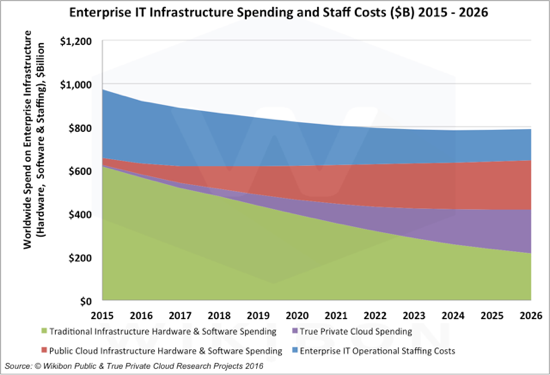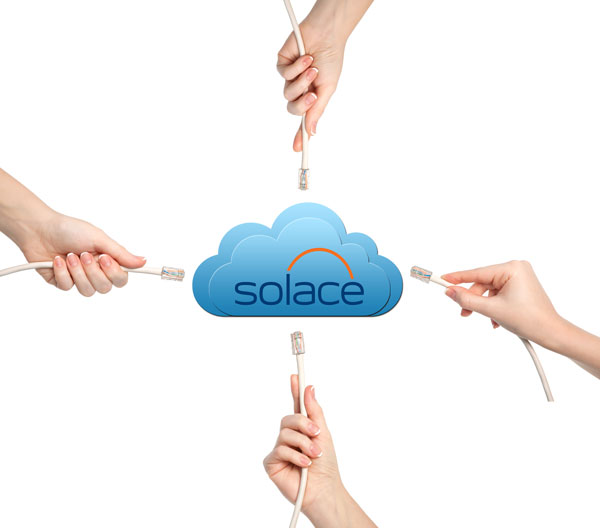Driven by the ability to build new applications faster and the promise of SaaS, clouds are becoming the de facto standard way to deliver business services and solutions. As this chart from Wikibon shows, enterprise investment in cloud (purple and red) is set to supplant and surpass traditional software and hardware spending (green) within ten years. That’s an unprecedented amount of change for a single decade in enterprise technology.
 More than anything, embracing cloud is about future-proofing. As companies migrate mission-critical workloads from traditional systems to clouds, they want freedom (no lock-in), flexibility (ability to move workloads as desired) and continuity (progress and migration without disruption).
More than anything, embracing cloud is about future-proofing. As companies migrate mission-critical workloads from traditional systems to clouds, they want freedom (no lock-in), flexibility (ability to move workloads as desired) and continuity (progress and migration without disruption).
That means you need to be able to choose your clouds at will, public or private. To choose your environment at both the IaaS and PaaS layers. To build hybrid solutions that factor your existing infrastructure into the equation. And to work with open, standardized APIs and protocols that will meet your needs now and in the future.
Solace’s Strategic Cloud Commitment
 To help you do all that, Solace today announced a strategic commitment to provide messaging and open data movement that runs in not just one cloud, nor a category of clouds, but in all the cloud technologies you might want to leverage as go through the multi-year process of architecting, building, scaling and inevitability re-architecting your complex hybrid cloud infrastructure.
To help you do all that, Solace today announced a strategic commitment to provide messaging and open data movement that runs in not just one cloud, nor a category of clouds, but in all the cloud technologies you might want to leverage as go through the multi-year process of architecting, building, scaling and inevitability re-architecting your complex hybrid cloud infrastructure.
As an example of that commitment, we’ve been working closely with Pivotal, the providers of the popular Cloud Foundry PaaS, to fully integrate Solace as a new Pivotal Cloud Foundry Tile called the Solace Messaging Service.
We’ve previously supported AWS, SAP Hana and OpenStack, Mirantis, HP Helion and VMWare, and today we announced we’ll be adding support for Microsoft Azure, IBM BlueMix and OpenShift in the coming months. As you can see we’re covering the entire gamut: public and private, PaaS and IaaS, commercial and open source, with full continuity alongside the assets still in your traditional datacenter environment.
So with all those clouds floating around, why is our support across clouds so exciting?
Applications today are increasingly found in both public and private clouds, and run on top of a wide range of IaaS technologies. To date, that data movement has been hampered by the lack of tools to cross the barriers. Many architects and developers we work with need to remove the application barriers for hybrid clouds, and get excited about any solution set that enables hybrid data movement.
Further, keep in mind that open data movement entails the need to cross IaaS and datacenter boundaries. With Solace (which allows you to use your open protocol and open API of choice), you can stream or otherwise move your data where you need it as you need it: pub/sub, request/reply, streaming, fanin/fanout, bridging to legacy, etc. You just pick the appropriate message exchange pattern and quality of service, and let Solace handle the heavy lifting of routing messages and guaranteeing their delivery when that’s necessary.
That’s why we’re so thrilled to be offering the new Pivotal Cloud Foundry Tile for Solace messaging. The PCF Tile makes the VMR’s services available to applications running in PCF via the PCF Marketplace. When our Tile is deployed in a PCF environment, Solace Messaging appears in the Marketplace of that PCF environment and application developers can bind their application to our messaging service like they would for any other.
Conclusion
Solace’s open data movement approach lets you pick the clouds that are right for you with the flexibility to change your strategy as technologies and markets develop. You can freely share data between workloads across clouds and your legacy solutions. Scaling and protocol bridging are handled by the messaging layer, instead of your code. All that while avoiding lock-in through the use of open standard protocols and open APIs.
The future might be full of clouds, but open data movement makes everything clear.
Explore other posts from category: Products & Technology

 Solace
Solace
